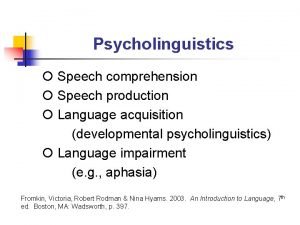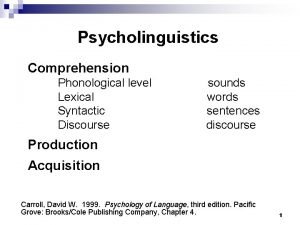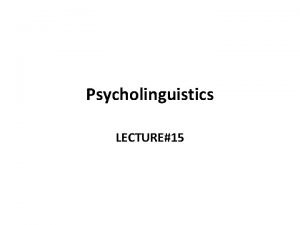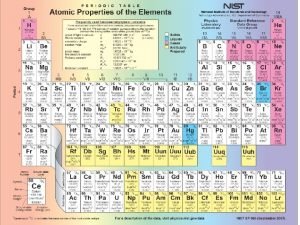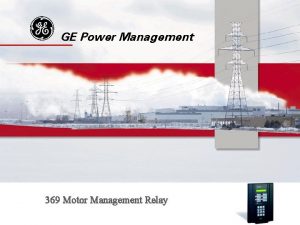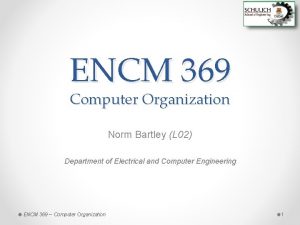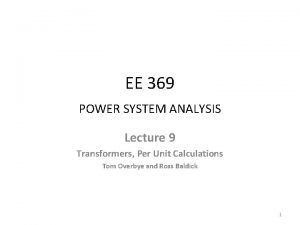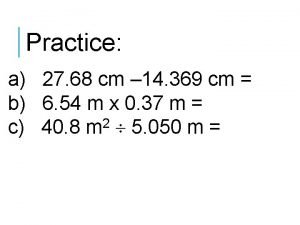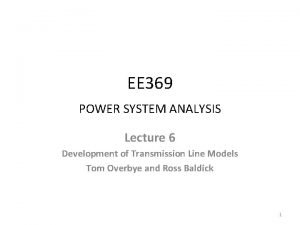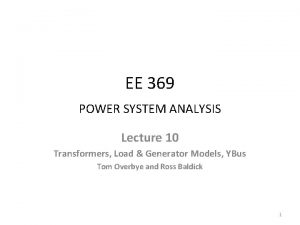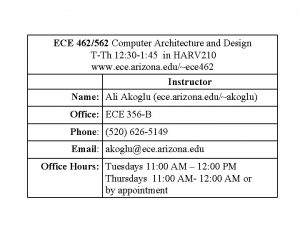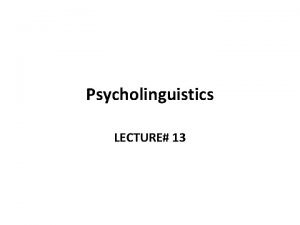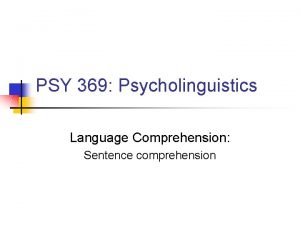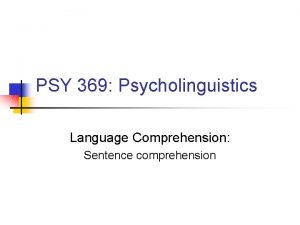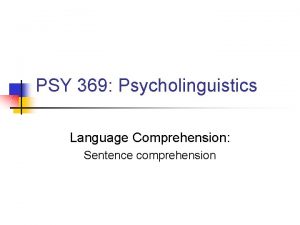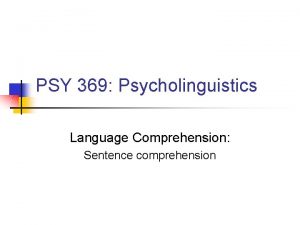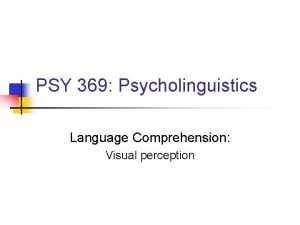PSY 369 Psycholinguistics Language Comprehension Discourse Homework 3






































- Slides: 38

PSY 369: Psycholinguistics Language Comprehension: �Discourse

Homework 3 (Due in 1 week) n Try to be vigilant for four or five days in noting speech errors made by yourself and others. Write each slip down (carry a small notebook and pencil with you). Then, when you have accumulated a reasonably size sample (aim for 20 to 30, but don't panic if you don't get that many), try to classify each slip in terms of n n the unit(s) involved the type of error n Remember that each error may be interpreted in different ways. For some of them, see if you can come up with more than one possibility.

n Read story aloud

Discourse Psycholinguistics n n How we resolve/understand sentences against the current discourse representation What is discourse? n n Units of analysis larger than a sentence Local Structure (microstructure): n The relationship between individual sentences n n n Coherence Cohesion Global Structure (macrostructure): n The relationship between the sentences and our knowledge of the world

Characteristics of Discourse n Global Structure (macrostructure): n The relationship between the sentences and our knowledge of the world Jill bought a new sweater. Sweater are sometimes made of wool. Wool production gives some farmers a good livelihood. Farming is a high-risk business. On the news last night, I saw a group of business executives discussing recent trends in the stock market.

Characteristics of Discourse n Global Structure (macrostructure): n Okay local structure, but each sentence isn’t relevant to an overall topic of discourse Jill bought a new sweater. Sweater are sometimes made of wool. Wool production gives some farmers a good livelihood. Farming is a high-risk business. On the news last night, I saw a group of business executives discussing recent trends in the stock market.

Characteristics of Discourse n Global Structure (macrostructure): n Schemas & Scripts n n General knowledge structures for common social situations Genres n Narrative structure n n Story grammars - extension of idea of grammatical rules, specify the organization of a story Expository structure n Different structures

Effects of world knowledge Rocky slowly got up from the mat, planning his escape. He hesitated a moment and thought. Things were not going well. What bothered him most was being held, especially since the charges against him had been weak. He considered his present situation. The lock that held him was strong but he thought he could break it. He knew, however, that his timing would have to be perfect. Prison escape OR Wrestling match

Effects of world knowledge n Bartlett (1932) n n n Read native American folk tale Write down everything that you can remember from that story that I read earlier Bartlett had them recall after a longer periods of time (between 15 mins. Up to 10 years later)

Effects of world knowledge n Bartlett (1932) n Participants’ memories changed to fit their existing beliefs (reconstructive memories) n n Added new details Changed details Deleted details Schema n n Mental structures of how the world works, acquired through experience A whole package of information used to facilitate comprehension of discourse, as well as to guide recall (and reconstruction)

Effects of world knowledge n Invernizzi& Abouzeid (1995) n n Read two European tales 2 audiences n n European North American children Ponam children (New Guinea)

Effects of world knowledge n Invernizzi& Abouzeid (1995) n n Retelling of boy who cried wolf Ponam children (New Guinea) n Once upon a time Kalai and his family they lived on an island. Kalai’s mother always carried him everywhere. One day Kalai’s mother and father went out fishing. Kalai’s mother said, “Kalai, you are too small to go out fishing in the sea. You should stay home with your grandfather. ” Kalai was lonely on the beach. Kalai said, “How could I get my family home? ” He sat down and decided to get his family home. He got his red laplap and ran down to the beach and waved his laplap to his family and said, “Fire, fire. ” His brother saw his laplap and went home. When they arrived they saw nothing.

Effects of world knowledge n Invernizzi& Abouzeid (1995) n n Retelling of boy who cried wolf European North American children n Kalai was running up and down the beach yelling “Fire, fire. ” Everybody came home. The next day the same thing happened. They came home. The next day came, but the house caught on fire. He ran up and down the beach, but nobody came. Kalai kept waving the flag. Nobody came. Suddenly they saw the flames and the smoke and they came, but it was too late. Everything had burnt down to the ground, and his brother told him if he kept telling lies that nobody will come when you call for help.

Effects of world knowledge n Invernizzi& Abouzeid (1995) n n Impact of different schemata European North American children n n Setting, precipitating events, goal reaching aspects, story resolutions Ponam children (New Guinea) n Recalled factual detail about settings, events, and outcomes, but leaving out things like consequence, resolution, moral (generally seemed to miss the point)

Effects of world knowledge n Scripts n Generic story of situations Restaurant Script Scene 1: Enter Scene 2: Order Scene 3: Eat Scene 4: Pay Go inside Go to table Sit down Get menu Read menu Choose food Give order Get food Eat food Ask for check Received check Tip waiter Pay check Exit

Effects of world knowledge n What happened to semantic networks? n One explanation n Some representations get so strongly associated that they get activated as an entire unit

Effects of Genre n Not all kinds of discourse follow the same structure n Different effects, purposes, etc. n Expository discourse n n Narrative discourse n n n Convey info about a subject (e. g. , textbook, lecture) Tell a story: Introduce characters & settings, establish a goal, etc. APA style Newspaper articles

Expository Structure n Reading texts, listening to lectures, etc. n n Organized with different relationships (but can still draw a tree structure) Relationships n n n Collection - ideas or events related on the basis of some commonality Causation - ideas are joined causally so that one idea is identified as the antecedent and another as the consequence Response - ideas are joined in a problem/solution or question/answer relationship Comparison - ideas are related by pointing out similarities and differences Description - general ideas are explained by giving attributes or other specific details

Narrative structure Once there was a woman. She saw a tiger’s cave. She wanted a tiger’s whisker. She put food in front of the cave. The tiger came out. She pulled out a whisker. n The story has a structure, a story grammar

Narrative structure n Story grammar - can depict with a tree structure Story Setting Episode Once there was a woman. Event She saw a tiger’s cave. Reaction Goal She wanted a tiger’s whisker. Overt Response Action Consequence She put food in front of the cave. Event The tiger came out. Event She pulled out a whisker.

Narrative structure Thorndyke (1977) n n n Level effect High hierarchy statements Lower in the hierarchy. n Read more slowly but are better remembered. Comprehensibility and recall were tied to inherent plot structure, independent of passage content She wanted a tiger’s whisker. The tiger came out.

Characteristics of Discourse Trabasso & Suh (1993) n n Test to see if structure effects whether inferences are made Task: Think aloud task n Read through the story aloud (one sentence at a time) and talk aloud about their understanding of that sentence

Trabasso & Suh (1993) Sequential version Hierarchical version Once there was a girl named Betty. One day, Betty found that her mother’s birthday was coming soon. Betty really wanted to give her mother a present. Betty went to the department store. Betty found a pretty purse. Betty found that everything was too expensive. Betty bought the purse. Betty could not buy anything. Her mother was very happy. Betty felt sorry. Several days later, Betty saw her friend knitting. Betty was good at knitting. Betty decided to knit a sweater. How does this sentence connect up Betty selected a pattern from a magazine. with. Betty thefollowed rest ofthe story? in the article. instructions Finally, Betty finished a beautiful sweater. Betty pressed the sweater. Betty folded the sweater carefully. Betty put it in the closet for the Betty gave the sweater to her mother. next time she was going out. Her mother was excited when she Berry was very happy. saw the present.

Trabasso & Suh (1993) Hierarchical version S Once there was a girl named Betty. E One day, Betty found that her mother’s birthday G A O O R E was coming soon. Betty really wanted to give her mother a present. Betty went to the department store. Betty found that everything was too expensive. Betty could not buy anything. Betty felt sorry. Several days later, Betty saw her friend knitting. S = Setting E = Event R = Reaction G = Goal O = Overt Response A = Action S G A A O R Betty was good at knitting. Betty decided to knit a sweater. Betty selected a pattern from a magazine. Betty followed the instructions in the article. Finally, Betty finished a beautiful sweater. Betty pressed the sweater. Betty folded the sweater carefully. Betty gave the sweater to her mother. Her mother was excited when she saw the present.

Trabasso & Suh (1993) Hierarchical version S Once there was a girl named Betty. E One day, Betty found that her mother’s birthday G A O O R E was coming soon. Betty really wanted to give her mother a present. Betty went to the department store. Betty found that everything was too expensive. Betty could not buy anything. Betty felt sorry. Several days later, Betty saw her friend knitting. S G A A O R Betty was good at knitting. Betty decided to knit a sweater. Betty selected a pattern from a magazine. Betty followed the instructions in the article. Finally, Betty finished a beautiful sweater. Betty pressed the sweater. Betty folded the sweater carefully. Betty gave the sweater to her mother. Her mother was excited when she saw the present. Is a superordinate goal that motivates the subgoal of the next episode S E G A E O S O G R A A A O R

Trabasso & Suh (1993) Sequential version S Once there was a girl named Betty. E One day, Betty found that her mother’s birthday G A O O R E S G A A O Betty was good at knitting. Betty decided to knit a sweater. Betty selected a pattern from a magazine. Betty followed the instructions in the article. Finally, Betty finished a beautiful sweater. Betty pressed the sweater. Betty folded the sweater carefully. Betty put it in the closet for the next time she was going out. R Berry was very happy. was coming soon. Betty really wanted to give her mother a present. Betty went to the department store. Betty found a pretty purse. Betty bought the purse. Her mother was very happy. Several days later, Betty saw her friend knitting. The goal is already filled, so not related to the subgoal of the next episode S E G A O E O S R G A A O

Trabasso & Suh (1993) Results n n In a think aloud task n participants mentioned the superordinate goal in the hierarchical condition n but not the sequential condition Story grammar structure matters n Strongly support the hypothesis that readers do make global causal connections during reading.

Discourse in memory n Evidence supports the psychological reality of a number of different representations n n n Propositions Semantic (propositional) networks Inferences Schemata and scripts Situation models

Discourse in memory n Kintsch’s model n n The Construction-Integration Model Discourse occurs in a series of cycles n n In each cycle n n n As each sentence comes in it gets integrated into the discourse Construction phase - activate relevant concepts Integration phase - keep only the most relevant elaborations Multiple levels of representation formed n Surface form, textbase (propositional), situation model

Discourse in memory n Kintsch and colleagues (1990) It was Friday night and Jack and Melissa were bored, so they decided to catch a movie. Jack scanned the newspaper. He saw that they could just make the nine o’clock showing of the hot new romantic comedy. Off they went. n Read before Did this sentence occur in the paragraph? Jack scanned the newspaper. Jack looked through the movie ads. Jack looked over some editorials.

Discourse in memory n Kintsch’s model Jack scanned the newspaper. Surface form S N VP V Jack scanned NP the newspaper

Discourse in memory n Kintsch’s model Jack scanned the newspaper. Surface form Textbase S N VP Examine V Jack scanned NP Newspaper the newspaper

Discourse in memory n Kintsch’s model Jack scanned the newspaper. Surface form. Situational Model Textbase S N VP Examine V Jack scanned NP Newspaper the newspaper

Discourse in memory n Kintsch and colleagues (1990) It was Friday night and Jack and Melissa were bored, so they decided to catch a movie. Jack scanned the newspaper. He saw that they could just make the nine o’clock showing of the hot new romantic comedy. Off they went. n Read before Similar meaning Did this sentence occur in the paragraph? Jack scanned the newspaper. Jack looked through the movie ads. Jack looked over some editorials. If Better memory here Evidence for surface form

Discourse in memory n Kintsch and colleagues (1990) It was Friday night and Jack and Melissa were bored, so they decided to catch a movie. Jack scanned the newspaper. He saw that they could just make the nine o’clock showing of the hot new romantic comedy. Off they went. n Read before Adds inference Did this sentence occur in the paragraph? Jack scanned the newspaper. Jack looked through the movie ads. Jack looked over some editorials. Infers which section did he scan. If Better memory here Evidence for Strong textbase

Discourse in memory n Kintch and colleagues (1990) It was Friday night and Jack and Melissa were bored, so they decided to catch a movie. Jack scanned the newspaper. He saw that they could just make the nine o’clock showing of the hot new romantic comedy. Off they went. n consistent inconsistent Did this sentence occur in the paragraph? Jack scanned the newspaper. Jack looked through the movie ads. Jack looked over some editorials. Consistent with situation model. Evidence for Strong situation model If Better memory here

Discourse in memory n Kintch and colleagues (1990)

Summary n Discourse processing is both complex and flexible n n Multiple representations Processing depends on context
 Developmental psycholinguistics
Developmental psycholinguistics Puldow cross
Puldow cross Comprehension of words in psycholinguistics
Comprehension of words in psycholinguistics Discourse in linguistics
Discourse in linguistics Language loss in psycholinguistics
Language loss in psycholinguistics Short division vs long division
Short division vs long division Cs 369
Cs 369 369
369 +multilin +369 motor management relay
+multilin +369 motor management relay Encm 369
Encm 369 369 meaning
369 meaning 369 power
369 power Bio 369
Bio 369 369 project
369 project 369 project
369 project 369 power
369 power 파이썬 369 짝짝
파이썬 369 짝짝 369 power
369 power Task level parallelism
Task level parallelism Homework oh homework
Homework oh homework Homework oh homework i hate you you stink
Homework oh homework i hate you you stink Jack prelutsky homework oh homework
Jack prelutsky homework oh homework Homework oh homework
Homework oh homework Alitteration definition
Alitteration definition Grant always turns in his homework
Grant always turns in his homework Euro psy
Euro psy Ucf psychology bs
Ucf psychology bs Psy 2055
Psy 2055 Psy 2055
Psy 2055 Xxxxblue
Xxxxblue Psy
Psy Psy sanin
Psy sanin Psy
Psy Psy 421
Psy 421 Psy
Psy Psy
Psy Psy 226
Psy 226 Psy
Psy Psy academy
Psy academy
